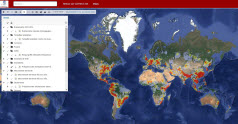The distant sound of an undersea eruption has geologists scrambling to explore the water's off Northern California and southern Oregon for signs of the volcanic activity. Using recordings from the classified Navy's Sound Surveillance System hydrophones, scientists with the National Oceanic and Atmospheric Administration have zeroed in on the rumbling of magma, or lava, as it moves close to the sea floor surface and perhaps is now erupting.
As (magma) breaks through the rocks it creates a lot of small earthquakes," said Chris Fox, who runs the undersea acoustical monitoring program at NOAA's Pacific Marine Environmental Laboratory in Newport, Oregon. "We really don't know that it's erupted until we get down and see it."
Since the magma started moving last week, there has been one small quake almost every 30 seconds. Some of them have been picked up by land-based seismometers, Fox said. The sound of those earthquakes, sped up 16 times, is audible to human ears. Similar sounds picked up by seismometers aren't so easy to "hear" because they travel through the jumbled medium of rocks instead of just one consistent medium: water.
All the seismic burbling comes from the Gorda Ridge, an area where the sea floor is spreading apart and lava from deeper in the earth fills in the gap. It's a place where, as on the better known Mid-Atlantic Ridge, oceanic crust is being created. Oceanographers are already at sea today in the Gorda Ridge area looking for signs of the eruption in the water. Past undersea eruptions have given off helium gas or even floating pumice or volcanic ash, which can be detected by research ships, said Alice Davis, a marine geologist at the Monterey Bay Aquarium Research Institute.
Because of their deep-sea locations, little is known about these eruptions, said Davis. For instance, an undersea version of the explosive Mount St. Helens eruption would be a very different beast because of the weight of water on the volcano. Getting a better understanding of such eruptions could help scientists understand tsunamis, which can be triggered by explosive eruptions.
Less violent eruptions like that on the Gorda Ridge give geologists clues to how the Earth makes its crustal plates. They also can release very primitive life forms that live inside seafloor rocks. These creatures may hold clues to how life started on Earth or could exist in places like Jupiter's icy moon Europa, said Fox.
Source : USGS
 s'abonner
s'abonner





































